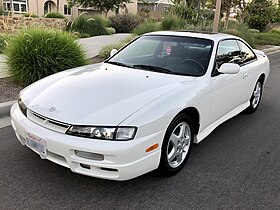
The Toyota Celica is an automobile produced by Toyota from 1970 until 2006. The Celica name derives from the Latin word coelica meaning heavenly or celestial. In Japan, the Celica was exclusive to the Toyota Corolla Store dealer chain. Produced across seven generations, the Celica was powered by various four-cylinder engines, and bodystyles included convertibles, liftbacks, coupés and notchback coupés.
The Nissan 200SX is an automobile nameplate that has been used on various export specification Nissan automobiles between 1975 and 2002.
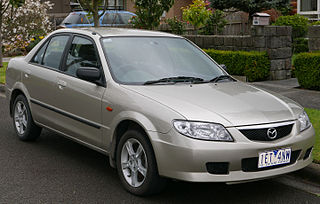
The Mazda Familia, also marketed prominently as the Mazda 323, Mazda Protegé and Mazda Allegro, is a small family car that was manufactured by Mazda between 1963 and 2003. The Familia line was replaced by the Mazda3/Axela for 2004.
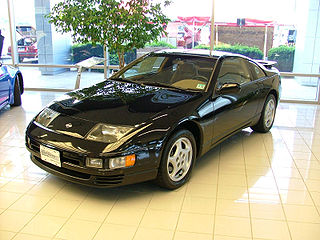
The Nissan 300ZX is a sports car that was produced across two different generations. As with all other versions of the Z, the 300ZX was sold within the Japanese domestic market under the name Fairlady Z.

The Infiniti M is a line of mid-size luxury (executive) cars from the Infiniti luxury division of Nissan. From 2013 on it has been marketed as the Infiniti Q70, reflecting the company's new naming scheme.

The SR engine is a series of 1.6 L (1,596 cc), 1.8 L (1,838 cc) or 2.0 L (1,998 cc) straight-four, four-stroke gasoline engines manufactured by Nissan. It has an aluminium head and block with steel sleeves and has a DOHC 4-valve design, with variable valve timing on select models.
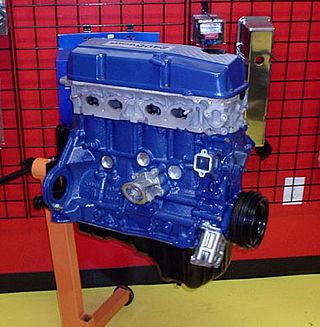
The KA engines were a series of four-stroke inline-four gasoline piston engines manufactured by Nissan, which were offered in 2.0 and 2.4 L. The engines blocks were made of cast-iron, while the cylinder heads were made of aluminum.

The Nissan Sentra is a series of automobiles manufactured by the Japanese automaker Nissan since 1982. Since 1999, the Sentra has been categorized as a compact car, while previously it occupied the subcompact class. Until 2006, Sentra was a rebadged export version of the Japanese Nissan Sunny, but since the 2013 model year, Sentra is a rebadged export version of the Sylphy. The Sentra nameplate is not used in Japan. Many other countries in Latin America sell their versions of the Sunny as the Sentra. In Mexico, the first three generations of the Sentra were known as the Nissan Tsuru, and the B13 model was sold under that name until 2017, alongside the updated models badged as Sentra.

The CA engine is a series of 1.6 to 2.0 L Inline-4 piston engines from Nissan. It is designed for a wide variety of smaller Nissan vehicles to replace the Z engine and some smaller, four-cylinder L series engines. The "CA" stands for Clean Air, due to the installation of Nissan emission reducing technology, called NAPS-X.
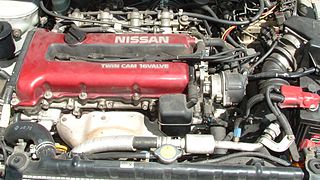
The SR20DET is a 2.0 L (1,998 cc) straight-four four-stroke gasoline engine that is part of the SR family of engines from Nissan, produced from 1989 to 2002. It is a turbocharged version of the SR20DE engine and is a replacement of the CA18DET engine.

The Infiniti G Line is a series of compact executive cars manufactured and marketed by Infiniti, a luxury division of Nissan, for the 1991–1996 and 1999–2016 model years — across four generations.

The Nissan NX is a front wheel drive 2-door sports car produced by Nissan Motors. The NX was, loosely, an evolution of the Nissan Pulsar NX/Nissan EXA sold from 1987 to 1990 and the Nissan Sunny Coupe lines of the 1970s and 1980s, merging the Nissan B13 and N14 lineages. The NX was released in Japan in 1990.

The Nissan 180SX is a fastback automobile that Nissan Motors produced between 1988 and 1998. It is based on the S13 chassis from the Nissan S platform with the variants receiving an R designation. It was sold exclusively in Japan paired with the CA18 motor in the early models; later models paired with the SR20 motor. Outside of Japan, it was re-badged as the 200SX and in the US market as the Nissan 240SX, paired with the single overhead cam KA24E motor and later with the dual-overhead model KA24DE.

The Nissan Lucino is a small automobile nameplate used by the Japanese manufacturer Nissan between 1994 and 2000. The Lucino name applied simultaneously to a pair of entirely different vehicles—a two-door coupé version of the Sunny/Sentra (B14)—and badge engineered versions of the Nissan Pulsar (N15) three- and five-door hatchbacks. For Japan, coupés arrived first in 1994, followed by hatchbacks in 1995. Production in Japan ended in 1999, except for the five-door that lingered on until 2000.

The Corolla E90, introduced in 1987 for the 1988 model year, was the sixth generation of cars sold by Toyota under the Corolla nameplate. It was the last generation of Corolla to be classified as a subcompact car and the first to be exclusively front-wheel drive or all-wheel drive; the performance option of rear-wheel drive was dropped.

The Toyota Corolla E80 is a range of small automobiles manufactured and marketed by Toyota from 1983 to 1987 as the fifth generation of cars under the Corolla and Toyota Sprinter nameplates, with production totaling approximately 3.3 million, and most models adopting a front-wheel drive layout.

The sixth-generation Honda Civic is an automobile produced by Honda from 1995 until 2000. It was introduced in 1995 with 3-door hatchback, 4-door sedan and 2-door coupe body styles, replicating its predecessor's lineup. The sixth-generation Civic offered two new 1.6-liter 4-cylinder engines and a new continuously variable transmission (CVT) on the HX model. The coupe and sedan are 2.3 in (58 mm) longer and the hatchback is 4.3 in (109 mm) longer than the previous-generation Civic. This was the last generation of Civic to have front double-wishbone suspension, as the succeeding seventh generation would change the front suspension to a MacPherson strut.

The seventh-generation Honda Civic is an automobile produced by Honda from 2000 until 2005. It debuted in September 2000 as a 2001 model. Its exterior dimensions stayed similar to the outgoing predecessor, with interior space significantly increased, bumping it up to the compact car size designation. A notable feature was the flat rear floor that gave better comfort to the rear seat passengers. This generation abandoned the front double wishbone suspension, used previously from fourth to sixth generations, replacing it with MacPherson struts. This generation was the last to offer 4WD variants.
The Nissan Pulsar EXA and Nissan EXA are automobiles manufactured and marketed by Nissan Motor Company from 1983 to 1986 and from 1986 to 1990 respectively. The first generation model was internally designated as the N12 series and was marketed in Japan at Nissan Cherry Store locations as the Pulsar EXA. The second generation EXA was designated as the N13 series.

The Nissan Silvia is the series of small sports cars produced by Nissan. Versions of the Silvia have been marketed as the 200SX or 240SX for export, with some export versions being sold under the Datsun brand.





